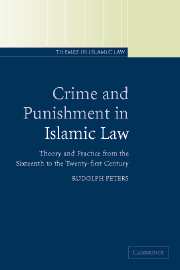 Crime and Punishment in Islamic Law
Crime and Punishment in Islamic Law Book contents
- Frontmatter
- Contents
- Acknowledgements
- Maps
- 1 Introduction
- 2 The classical doctrine
- 3 The implementation of Islamic criminal law in the pre-modern period: the Ottoman Empire
- 4 The eclipse of Islamic criminal law
- 5 Islamic criminal law today
- 6 Conclusion
- Glossary of technical terms
- Bibliography
- Suggestions for further reading
- Index
2 - The classical doctrine
Published online by Cambridge University Press: 23 November 2009
- Frontmatter
- Contents
- Acknowledgements
- Maps
- 1 Introduction
- 2 The classical doctrine
- 3 The implementation of Islamic criminal law in the pre-modern period: the Ottoman Empire
- 4 The eclipse of Islamic criminal law
- 5 Islamic criminal law today
- 6 Conclusion
- Glossary of technical terms
- Bibliography
- Suggestions for further reading
- Index
Summary
INTRODUCTION
In this chapter I will discuss and analyse the classical doctrine of criminal law as found in the authoritative works of jurisprudence. I will pay attention to the various schools of jurisprudence (madhhab, plural madhāhib), including Shiite doctrine, and try to present the authoritative opinions of each school. This may seem somewhat confusing to the reader but it is necessary, first in order to convey how rich and variegated the legal discourse is, and second because I will refer to these opinions in the following chapters. To avoid further confusion, I will refrain from paying attention to the historical development of the doctrine, although I am well aware that the doctrine was not static and immutable. However, this is only recently recognised and there are still many gaps in our knowledge.
In order to make the variety of opinion manageable in practice and to impose some sort of order on it, two devices were used. The first and older one is the institution of the school of jurisprudence. Scholars tracing their doctrine to the same early authority regarded themselves as followers of the same school. Ultimately, there remained four of them in Sunni Islam: the Hanafites, Malikites, Shafi῾ites and Hanbalites. These schools had, to some extent, a regional distribution: for instance, North Africa and Islamic Spain adhered to the Malikite school, Central Asia and the territory occupied by the Ottoman Empire was dominated by the Hanafites.
- Type
- Chapter
- Information
- Crime and Punishment in Islamic LawTheory and Practice from the Sixteenth to the Twenty-First Century, pp. 6 - 68Publisher: Cambridge University PressPrint publication year: 2006
- 1
- Cited by
